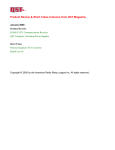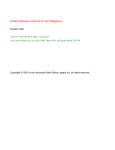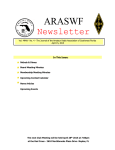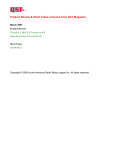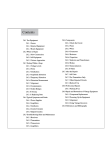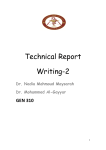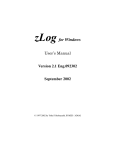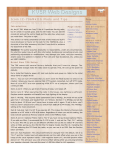Download Alinco DX-77T Technical information
Transcript
Product Review Edited by Rick Lindquist, N1RL• Senior Assistant Technical Editor Alinco DX-77T MF/HF Transceiver Reviewed by Joe Bottiglieri, AA1GW ARRL Technical Information Service Coordinator With improvements in propagation on the HF bands over the last few months, stories of wide-open bands and easy DX are rapidly spreading. If you’re a newcomer looking to join the fun without cleaning out the bank account, upgrading from “hollow state,” or are just considering a new or second HF radio for your shack (or at that second QTH in the woods), the Alinco DX-77T may be just the ticket. Here’s an economical HF box in the $1000 price category that won’t take up a lot of space on the operating desk but still has plenty to offer. Already known for its VHF and UHF products, Alinco entered the HF market in 1995 with the release of the DX-70T. This compact HF-plus-6 meters transceiver proved to be a popular choice for mobile, home station, and portable operation. A subsequent model, the DX-70TH, offered 100 W on 6 meters. With the introduction of the DX-77T, Alinco now adds a somewhat larger HF-only transceiver to their lineup. What’s it Got? The DX-77T is a 100 W output SSB, CW, FM and 40 W AM transceiver that covers 160 through 10 meters and includes 0.5 to 30 MHz general-coverage receiving capability. It features dual VFOs, split operation, 100 memory channels, band stacking registers, a speech processor, IF shift, multiple scan options, computer controllability, and a front-facing speaker. But wait! A built-in CW keyer, 500Hz CW filter, and menu selectable CTCSS encode for 10meter FM repeater operation also are all standard features (in the US version). In comparison, setting CTCSS tones in the DX-70T required setting DIP switches, and the earlier radio had no CW keyer. While Alinco has managed to pack in some very nice capabilities, they’ve also kept the front panel surprisingly simple and functional, with just a few large buttons and knobs and bold, bright labels. Physically larger than the current crop of subcompact base/mobile type HF transceivers on the market the DX-77T is a more convenient size for desktop or portable operation. Many users will welcome the generous dimensions. You could almost operate this radio with oven mitts on! Although it’s on the small side, the busy LCD display offers good contrast and easy readability. Backlighting is adjustable to 52 June 1998 five brightness levels (or off altogether). In addition to the operating frequency, the window displays icons for mode, noise blanker, AGC slow or fast (AGC cannot be disabled), memory number, VFO A and B, split, narrow CW filter, CTCSS tone state, RIT offset and low power. A four-section readout indicates the state of the two-stage attenuator/ normal/or 10-dB preamplifier RF gain level. An LCD bargraph-type S meter indicates relative power output on transmit. Up Front The front panel sports 14 buttons and four knobs, with one concentric control. The all-mode SQUELCH and AF GAIN controls are huge by today’s standards, almost 5/ 8 inch in diameter! The RIT and IF shift knobs are a concentric pair, mounted in the upper right corner. Center detents in their travel indicate zero settings, with RIT adjustable to approximately ±1.0 kHz. The RIT function is always available—there’s no way to clear it or turn it off. Some users might find this a disadvantage. BOTTOM LINE A $1000-class desktop radio, the DX-77T is easy to use and a moderately good performer with some nice features you wouldn’t typically expect at this price. The large main tuning knob spins smoothly (some users thought a little too easily, however), is lightly weighted, and includes a finger dimple. The tuning rate is fixed at 2 kHz per knob revolution for SSB/CW and 10 kHz per revolution for FM/ AM. A DIAL LOCK button is located to the lower right of the main knob. For large changes in frequency, the SELECT button used in conjunction with the front panel UP and DOWN buttons allows stepping through the band registers and memory channels, or frequency changes in 1 MHz or 100 kHz steps. Smaller mode-related step sizes are selectable in the set mode. A small frontfacing speaker sends the audio in the right direction, a very nice arrangement. A jack for an 8-pin microphone connection and 3.5-mm jacks for an external key or paddles, an external speaker, and headphones are mounted along the bottom of the speaker grille. The POWER ON/OFF switch is a large yellow push button located in the top left corner. Side-by-side green and red LEDs just to the left of the display window indicate transmit or receive, with the green LED showing received signal, and the red showing transmit, with increasing brightness on ALC peaks. Four large, black, rectangular buttons form a vertical row to the left of the main tuning knob. Side-byside white and light green legends above each button indicate their primary and sec- Table 1 Alinco DX-77T, serial number T000528 Manufacturer’s Claimed Specifications Frequency coverage: Receive, 0.5 to 30 MHz; transmit, 1.8-2, 3.5-4, 7-7.3, 10.1-10.15, 14-14.35, 18.068-18.168, 21-21.45, 24.89-24.99; 28-29.7 MHz. Size (height, width, depth): 3.9×9.7×10.5 inches; weight, 8.4 pounds. Power requirement: Receive, 1.1 A (max); transmit, 20 A (max). Modes of operation: SSB, CW, AM, FM, WBFM. Measured in the ARRL Lab As specified. Receiver SSB/CW sensitivity, bandwidth not specified: 0.5-1.8 MHz, –107 dBm; 1.8-30 MHz, –119 dBm. Receiver Dynamic Testing Minimum discernible signal (noise floor), 500 Hz filter: Preamp off Preamp on 1.0 MHz –127 dBm –129 dBm 3.5 MHz –132 dBm –140 dBm 14 MHz –130 dBm –136 dBm 10 dB (S+N)/N, 1-kHz tone, 30fi modulation: Preamp off Preamp on 1.0 MHz 3.2 µV 1.9 µV 3.8 MHz 1.4 µV 0.6 µV For 12 dB SINAD: Preamp off Preamp on 29 MHz 0.7 µV 0.2 µV Blocking dynamic range, 500 Hz filter: Preamp off Preamp on 3.5 MHz 109 dB* 110 dB* 14 MHz 111 dB* 112 dB* Two-tone, third-order IMD dynamic range, 500 Hz filter: Preamp off Preamp on 3.5 MHz 92 dB* 93 dB* 14 MHz 94 dB* 95 dB* Preamp off Preamp on† 3.5 MHz +12.6 dBm +4.5 dBm 14 MHz +17.3 dBm +9.5 dBm Preamp off, +53 dBm; preamp on, +51.5 dBm. 29 MHz: 60 dB, at 20 kHz channel spacing, preamp on. 29 MHz: 63 dB* at 20 kHz channel spacing, preamp on. S9 signal at 14.2 MHz: preamp off, 36 µV; preamp on, 16 µV. At threshold, preamp on: SSB, 14 MHz, 1.0 µV; FM, 29 MHz, 0.1 µV. 2.1 W at 10% THD into 8 Ω. Range at –6dB points, (bandwidth): CW-N (500 Hz filter): 525-1027 Hz (500 Hz); CW-W: 150- 2288 Hz (2138 Hz); USB-W: 216-2977 Hz (2761 Hz); LSB-W: 186-2834 Hz (2648 Hz); AM: 146-2894 Hz (2748 Hz). First IF rejection, 114 dB; image rejection, 104 dB. AM sensitivity, 10 dB S/N: 0.5-1.8 MHz, 10 µV; 1.8-30 MHz, 2 µV. FM sensitivity, 12 dB SINAD: 0.5 µV. Blocking dynamic range: Not specified. Two-tone, third-order IMD dynamic range: Not specified. Third-order intercept: Not specified. Second-order intercept: Not specified. FM adjacent channel rejection: Not specified. FM two-tone, third-order IMD dynamic range: Not specified. S-meter sensitivity: Not specified. Squelch sensitivity: Not specified. Receiver audio output: 2 W at 10% THD into 8 Ω. IF/audio response: Not specified. Spurious and image rejection: 70 dB. Transmitter Power output: SSB, CW, FM: 100 W high, ≈10 W low; AM, 40 W high, ≈4 W low. Spurious-signal and harmonic suppression: 50 dB (45 dB on 30 M). Receive, 0.8 A; transmit, 16 A. Tested at 13.8 V. As specified. Transmitter Dynamic Testing CW, SSB, FM, typically 106 W high, 11 W low; AM, typically 42 W high, 6 W low. 52 dB. Meets FCC requirements for spectral purity for equipment in its power output class and frequency range. As specified. As specified. >60 dB. See Figure 1. 6 to 49 WPM. See Figure 2. S9 signal, 19 ms. SSB carrier suppression: 40 dB. Undesired sideband suppression: 50 dB. Third-order intermodulation distortion (IMD) products: Not specified. CW keyer speed range: Not specified. CW keying characteristics: Not specified. Transmit-receive turn-around time (PTT release to 50 % audio output): Not specified. Receive-transmit turn-around time (tx delay): Not specified. SSB, 20 ms; FM, 8 ms. Unit is suitable for use on AMTOR. Composite transmitted noise: Not specified. See Figure 3. Note: Unless otherwise noted, all dynamic range measurements are taken at the ARRL Lab standard spacing of 20 kHz ∗Measurement was noise-limited at the value indicated. † Third-order intercept was determined using S5 reference. ondary functions. The top button in this row serves as a function button, allowing access to the secondary functions and the set mode. The lower three buttons control various memory, VFO and scan features. There’s a second set of six buttons in two horizontal rows to the right of the main tuning knob. The top row contains single function buttons for SELECT, MODE, and TUNE (for use with an external automatic tuner). The second row are dual function buttons: RF/FILTER for RF gain level and CW filter, NB/AGC for noise blanker and automatic gain control fast or slow and H/L/TONE for power output level and CTCSS tone. All ten buttons also provide access to set mode controls, including the speech processor, display brightness, automatic LSB/USB selection, transmit inhibit, the step size of the UP/DOWN buttons, and several additional settings related to CW keyer and scan operations. A one page “Controls Quick Reference” table in the manual gives a description of the functions performed by each of these ten buttons in their primary, secondary and set mode applications. New users will definitely want to photocopy this chart and keep it handy. The only part about using this radio that can be confusing—at least at first—is that June 1998 53 0 –60 Reference Level: 0 dB PEP –10 –70 –20 –80 –30 –90 –40 –100 –50 –110 –60 –120 –70 –130 –80 –10 –8 –6 –4 –2 0 2 4 Frequency Offset (kHz) 6 8 –140 2 10 Figure 1— Worst-case spectral display of the Alinco DX-77T transmitter during twotone intermodulation distortion (IMD) testing. The worse-case third-order product is approximately 30 dB below PEP output, and the worse-case fifth-order product is approximately 41 dB down. The transceiver was being operated at 100 W output at 21.250 MHz. Figure 2 —The default CW keying waveform for the Alinco DX-77T showing the first two dits in full-break-in (QSK) mode using external keying. The equivalent keying speed is 60 wpm. The upper trace is the actual key closure; the lower trace is the RF envelope. Horizontal divisions are 10 ms. The transceiver was being operated at 100 W output at 14.2 MHz. This is excellent keying. The waveform was nearly identical using semi-break-in mode with the “auto” delay feature. you won’t find the set mode functions all in one place. Once you enter set mode, you’ll have to push different buttons to access different “menu” items. There’s a certain logic to it, however, and after a while, you will remember which settings reside behind which buttons on the front panel. phone wiring diagram. Two holes for mounting bracket hardware are on each side of the cabinet, although no mobile mounting bracket is currently available from Alinco. To the Rear! The back panel has jacks for connection of the required external 13.8 V dc, 20A power supply, an SO-239 antenna connection, and an attachment point for station ground. RCA (phono) jacks for amplifier relay and ALC controls, a five-conductor connector for control of an external automatic antenna tuner, and a 3.5 mm REMOTE jack for the optional Alinco ERW-4 computer-control interface also are included. This REMOTE jack allows memory cloning between two DX-77Ts. Simply connect the two radios with a length of cable with stereo 3.5-mm plugs on either end and activate the clone feature. Alinco says memory programming and remote control are on the horizon for the DX-77T. The software has not yet been developed, however. The control is via a serial port connection directly from the computer’s COM port to the stereo REMOTE jack on the rear panel (Alinco supplies the ERW-4 cable as an option). With suitable software, a user will be able to set and control most of the radio’s features including transmit and receive frequencies, output power, scanning start and stop, priority, split, mode, RF gain, AGC speed, noise blanker, CTCSS encoder, tune mode, filter, and various menu functions. The transceiver can report out its S meter reading, PTT status, squelch status, RIT status, memory channel information, split mode, and VFO or memory mode. Attachment of equipment for operating the digital modes (RTTY, PACTOR, AMTOR, etc.) is via the front panel microphone connector. Alinco thoughtfully includes fixed-level audio at this connector for easy hookup. The manual includes a micro- On the Air! Operating the DX-77T is fairly simple. A few seconds spent looking over the front panel and a quick glance at the aforementioned “Quick Reference” table should be enough to get most operators up and running. Once you have a feel for the interaction between the SELECT and UP / DOWN buttons, moving between frequencies, bands, or memory channels is easy. Major controls on this transceiver are very conveniently located, especially for right handers. Voice operation is a simple matter of selecting the mode with a few presses of the MODE button (the DX-77T steps through its modes), tuning to the desired frequency, setting the volume and squelch levels, and away you go! Power output level is limited to two levels: high power is 100 W output; low power is 10 W output (an internal switch allows switching these to 50 W and 5 W respectively). The microphone gain level is factory set. Those needing to make adjustments for their individual voice characteristics will find the location of and adjustment procedures for an internal mike gain control in the manual’s maintenance chapter, but this probably will not be necessary. Our reviewers reported very good to excellent transmit audio reports with the included mobile microphone at the factory gain setting. While this radio has an audio-level speech processor, it does not have VOX. Receive audio reports were mixed. The included speaker is considerably smaller than the front-panel grille would suggest. Most reviewers felt that with the internal speaker, the audio was somewhat tinnysounding. Predictably, using a larger exter- 54 June 1998 Reference Level: - 60 dBc/Hz Vertical Scale: dBc/Hz 4 6 8 10 12 14 16 18 20 Frequency Sweep: 2 to 22 kHz from Carrier 22 Figure 3— Worst-case tested spectral display of the Alinco DX-77T transmitter output during composite-noise testing. Power output is 100 W at 3.5 MHz. The carrier, off the left edge of the plot, is not shown. This plot shows composite transmitted noise 2 to 22 kHz from the carrier. nal speaker helped quite a bit. Alinco located the external speaker jack on the front panel. While this may be convenient in some situations, for most station arrangements the rear panel would be a better site for this jack. Maybe an additional jack on the back would provide the ultimate solution. We had complained some about the effectiveness of the noise blanker in the DX-70T. Apparently, Alinco listened and made the noise blanker in the DX-77T pretty aggressive. It works quite well on a variety of pulse-type interference—such as ignition noise—but it can impart some distortion to received signals under certain band or noise conditions. Overall, though, it will be an acceptable tradeoff for most users, we believe. Several features on this transceiver make the DX-77T a good choice for the CW operator. For starters, one of the most desirable CW options, a 500-Hz CW filter, already is installed! We peeked inside and were pleased to find a real crystal filter, too, not a ceramic job like the one in the DX-70T. You can opt to receive CW signals on either side of zero beat—CWU or CWL. This can help fight interference that might be on one side or the other of the station you’re trying to copy. You can zero beat a CW signal either by matching its tone in the CWU and CWL modes, or by a feature that allows matching the received signal’s pitch to that of the CW sidetone. Using the set mode, it’s possible to set the sidetone pitch anywhere between 400 Hz and 1000 Hz in 50 Hz increments. The IF shift control allows minor changes in the position of the IF filter’s passband—always an excellent feature for digging out weak signals under crowded band conditions. Radios in this price class typically don’t include built-in CW keyers, so it was a pleasant surprise to find one in the DX-77T. Nice going, Alinco! The keyer in this radio will generate code at between 6 and 50 words per minute, and it can operate fully automatic (iambic) as well as semi-automatic (bug style). Operation with a straight key, of course, is also possible. Whether you are connecting a straight key or a set of paddles, you must use a stereo type plug in the key jack. Pay close attention to the paddle wiring arrangement. The dot-and-dash connections are opposite to those found as the default settings on radios from other manufacturers (ie, Kenwood, ICOM, and Yaesu), and you can’t change this via the menu, as some radios let you do for “lefthand” and “right-hand” paddles. Transmit-receive switching for CW can be set to operate full-break-in, semi-breakin (adjustable to seven different delay times), or auto break-in, which will automatically adjust the delay time for the keying speed being used. The DX-77T was a pleasure to use on CW. With its wide range of interferencefighting capabilities, built-in electronic keyer, and smooth, multi-adjustable QSK, it earned high marks from our reviewers. Entry-class radios with built-in CW features like these could potentially put a dent in the sales of computer-generated CW practice programs! Shortwave and AM broadcast performance also was quite decent. You can select an 8 or 2.7-kHz AM filter bandwidth, and AM tuning step sizes of 1.0, 2.5, 5.0, 9.0 or 10 kHz for the front panel or microphone UP/ DOWN buttons, and scan modes make cruising for new stations easy. With the radio’s 100 memory channels, you can program lots of these and still have plenty left for your 10-meter FM repeaters and other favorite ham frequencies. A few words on our Lab testing results (see Table 1): The DX-77T stacked up pretty nicely with other transceivers in the same general price category. Dynamic range is always an important consideration. The higher the numbers, the better the receiver’s ability to hear a desired signal without being adversely affected by strong, neighboring signals (usually exhibited by AGC pumping). In this instance, the DX-77T’s twotone, third-order IMD dynamic range numbers showed up in the low to mid 90s—several dB better than we measured in the ICOM 706MkII (see “Product Review,” QST, Jan 1998), the Ten-Tec Scout (see “Product Review,” QST, Dec 1993), or the Kenwood TS-50S (see “Product Review,” QST, Sep 1993). In the IC-706MkII and the DX-77T, however, the level of measurement was limited by the transceiver’s phase noise, although the worst-case phase noise on the DX-77T was still an improvement over what we observed on our IC-706MkII. The DX-77T’s receiver is not quite as sensitive as the ICOM or the Kenwood, however, and this results in third-order intercept calculations well into the positive numbers, preamp off or on. Just a DX-70T in a New Box? We had first suspected the DX-77T was just a DX-70T in a desktop box. The famil- iar display window and the same integrated PA-heatsink/rear panel as those on the DX-70 fueled speculation that Alinco had just stripped off 6 meters and repackaged their previous HF offering. Inquiring minds want to know! A quick trip across the parking lot to liberate a DX-70T from one of W1AW’s guest operating positions, and it was back to the lab for a closer internal investigation. A few minutes with a screwdriver revealed the truth. While it seems these radios share some of the PA components and the LCD display, none of the internal boards was common to both transceivers. Those who do choose to take a look inside will be amazed at the amount of unused space in the DX-77T cabinet! Modern RF engineering techniques and miniaturized components have distilled the amount of actual volume necessary to support the long list of capabilities this transceiver provides to an unbelievably small level. A telephone answering machine of just a few years ago would contain twice the volume of electronics! Lab types gathered round and proposed various opinions on how best to occupy the vacant areas of its internal cavity (battery packs for portable QRP operation, home brew auto antenna tuners, switching power supplies, transverters, etc). So, while it was clear that the DX-77T has borrowed freely from its older sibling, it’s not really the same radio when you look under the hood. Also, as we’ve pointed out, it offers some features the DX-70T does not. In addition, it provides a rich computer-control interface that was not available on the DX-70T. Read All About It The Instruction Manual is excellent—an improvement from earlier Alinco books, and generating comments from the reviewers like “maybe Alinco’s best yet” and “obviously written by hams.” It’s easy to follow and includes lots of illustrations. A wellorganized table of contents, a “How to Use this Manual” page with a black page-edge tab arrangement for quickly locating specific topics, and a complete index make locating desired information a snap. Most of the sections on major operating parameters include a short introduction and explanation of the particular topic, plus step-by-step examples to help you along. This is a real boon to beginners. In addition to clear, concise instructions for operating the transceiver, the manual includes several “tutorials” that give tips to optimize performance in the radio’s various modes. Newcomers also will find these a welcome addition to the traditional manual fare. A maintenance chapter describes the location and adjustment of the internal controls for microphone gain, the 100 W/50 W maximum output switch, and CW sidetone and key activation “beep” volume. The frequency calibration procedure appears as well. Connection diagrams for Alinco’s optional EDX-1 manual or EDX-2 automatic antenna tuner also are shown, as well as wiring instructions for Kenwood’s AT-300 and ICOM’s AH-3 tuner units! A complete—though somewhat difficult to read—schematic is included. While you will find some typographical errors in the manual, they are very minor and don’t distract from the content. Consensus The overall impression of those who got to play with the Alinco DX-77T was that it’s a terrific “first steps” radio or a fine second radio. Indeed, some may find it a great “main” radio. It’s less adaptable to mobile use than some of the other offerings already on the market, but it’s not very large nor very heavy, so it’s good choice for portable use. The inclusion of a CW keyer and a decent narrow CW filter plus speech processing (even though it’s at audio) make this a slightly better than just the plain-vanilla starter boxes available just a few years ago. Some users felt that including a built-in ac power supply would make the DX-77T a killer product—sort of the latter-day equivalent of the Heath HW-16. With the long list of features already included in the DX-77T, first-time buyers may be curious as to what additional capabilities they would find in the next step up. Several other manufacturers offer midlevel radios for an added investment of $400 to $600. These may include items such as built-in automatic antenna tuners, digital signal processing (DSP), SWR metering, CW message memories, voice operated transmit (VOX), remotable faceplates, and additional IF filtering capabilities. In addition, manufacturers will usually include a few interesting extended features that may be unique to their products. While these certainly may be desirable, none classifies as an absolute necessity for effective communications. We also were pleased to report that everything worked the first time on our DX-77T, and that we did not encounter any situations where our unit failed to meet its published specifications or where it was seriously on the hairy edge of not meeting them. This increases our confidence in Alinco’s ability to turn out a radio that you won’t have to send back to the factory when it doesn’t work as advertised. Other manufacturers should take notice. Thanks to Dan Miller, K3UFG, Rick Lindquist, N1RL, and Mike Tracy, KC1SX, and Ed Hare, W1RFI of the ARRL Lab for their contributions to this review. Manufacturer: Alinco USA, 438 Amapola Ave, Suite 130, Torrance, CA 90501; tel 310-618-8616; fax 310-6188758; http://www.alinco.com. Manufacturer’s suggested retail price, DX-77T transceiver, $1059; EMS-14 desk microphone, $113; ERW-4 computer interface cable, $27; Alinco DM-340MVT power supply, $199. June 1998 55





